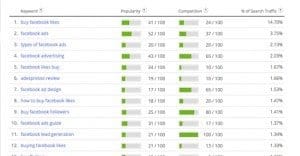10 Things to Learn about Your #1 Competitor’s SEO

Have you ever heard the phrase “keep your friends close, but your enemies closer?” The mentality behind it is pretty simple; you can trust your friends, so you only need to pay them moderate attention. You can’t trust your enemies, so you need to watch them like a hawk.
The idea carries forward in the world of business. Learning what you can about how your competitors operate will help you get an edge over them when push comes to shove. In SEO, particularly, you want a great deal of competitive knowledge. What are they doing, is it working, and can you do it better? Here are ten things you can learn, and tools to find out.
1. Media and Keyword Mentions – Google Alerts
Google Alerts is a surprisingly robust tool that has one simple purpose; leverage the vast and immediate power of the immense search index toward your own personal gain. Specifically, you can use it to alert you whenever specific keywords, brand names or people are mentioned in a newly indexed webpage.
Use Google Alerts to set up a few daily reports. You can tell Google to notify you when your competitors are mentioned on other blogs or on the news. You can find out when a keyword relevant to your niche is mentioned, in the context of new developments or announcements. You can find out when your brand is mentioned, to compare frequency and quality of those mentions.
2. Twitter Usage – Topsy
Twitter is all about quick, casual communication. If your competitors use Twitter – and they probably do – you can monitor them using this tool rather than the more traditional legwork of checking their account regularly. Given that your competitors probably won’t let you have access to their analytics, using third party analytics on their public tweet information is the next best thing.
Find out what tweets they make that have the most retweets, the most favorites, the most responses. Figure out how you can use and adapt those strategies for your own content marketing, if you’re not using them already. Twitter is so public you hardly need another tool.
3. Trend Monitoring – InfiniGraph
Infinigraph is a quick and easy tool that allows you to monitor trends taking place in your industry, based on your audience. You don’t need to plug it into your Facebook or website backend, though; it uses publicly available information to determine who your audience is and what’s trending in their circles.
This is a potent tool to learn about your own audience and your own trends, but it’s also great for competitive analysis. You can find out a surprising amount of detail about the trends in your competitor’s company and audience.
4. Backlink Monitoring – Monitor Backlinks
Pulling a detailed backlink profile for yourself can involve using half a dozen different tools and collating the results. Monitor Backlinks will pull a public backlink report, with some detailed analysis. It will give you an idea of what the newest links are, where they’re coming from, how much traffic they pass and what the comparative domain ranking is for each site.
Additionally, you can gain all of the same information about your competitors. Figure out who is linking to their site and where those links are coming from. Figure out if you can use those sources to your own benefit, or if they’re out of reach. Every resource you can usurp from your competition is a resource benefitting you instead of them.
5. Detailed Keyword Monitoring – SEMRush
SEMRush allows you to plug in a URL and get a readout of an incredible amount of detailed keyword information. You can see organic keywords that bring in traffic on the target site, the ad keywords that site targets, the number of competitors in those niches and a whole host of other variations on the information.
Plug in your competitors and learn, in a flash, what keywords they’re targeting. Figure out how many of those may be keywords you could compete over. Play tug of war with PPC bids and pull traffic away from your competition easier than ever before.
6. Competitor Discover – SimilarWeb
You probably think you have a very good grasp over your industry. After all, when a new player steps in or an old player falls, it’s generally news. You can learn a lot from watching how your competitors rise and fall, but you’re generally monitoring the same people.
In some niches, however – particularly those narrow niches where a small site can balloon overnight – it can come as a surprise to find competition you didn’t know existed, at least not until it’s starting to take your traffic. SimilarWeb helps you locate those potential competitors.
7. Deep General Analytics – Simply Measured
Once again, it’s very unlikely that your competitors are going to allow you the login information necessary to view their Google Analytics data. You’re going to have to satisfy yourself with what can be publicly monitored without internal code. Thankfully, that’s actually a lot of data. Simply Measured allows you to see almost a GA-like dashboard of reports, from among 35+ different sets of data, to find out everything you could want to know about any site that has a URL.
8. PPC Ad Monitoring – What Runs Where
Are your competitors using Facebook PPC? Are they using Google AdWords? Do they have affiliate links on ad networks in shadier parts of the Internet? This tool gives you as complete a readout of those answers as possible without having access to the internal data of your competition directly. After all, if an ad is going to be displayed, it needs to be public. Recording those ads is what this tool is all about.
This can help you identify the strategies your competitors are using in advertising, and will help you identify potential opportunities you may have missed.
9. General Property Ownership – SpyOnWeb
Ever wonder if some of those sites linking to your competitors are owned by their company? Ever wonder if some of those spam sites pointing your way fall under their ownership? Just curious whether or not they own any other sites? You can use this tool to get a readout of other properties owned by the owner of the property you plug in. Pull out the IP address of your competitors and immediately learn what other domains reside on that address.
10. Learn an Overall Ranking – Marketing Grader
Marketing Grader is a tool presented by Hubspot with the purpose of grading your site based on a wide range of criteria. It takes into consideration your social media presence, your blog frequency and quality, your public lead generation, your mobile compatibility and your on-page SEO, among other things.
While each individual aspect of your site may not be graded in deep detail, you can use this grader as a basic tool to let you know where you stand in regards to your competitor. If you’ve ever wanted to know, on a reasonably objective basis, whether you’re ahead or behind your competition, this tool can give you a good idea.
 ContentPowered.com
ContentPowered.com







